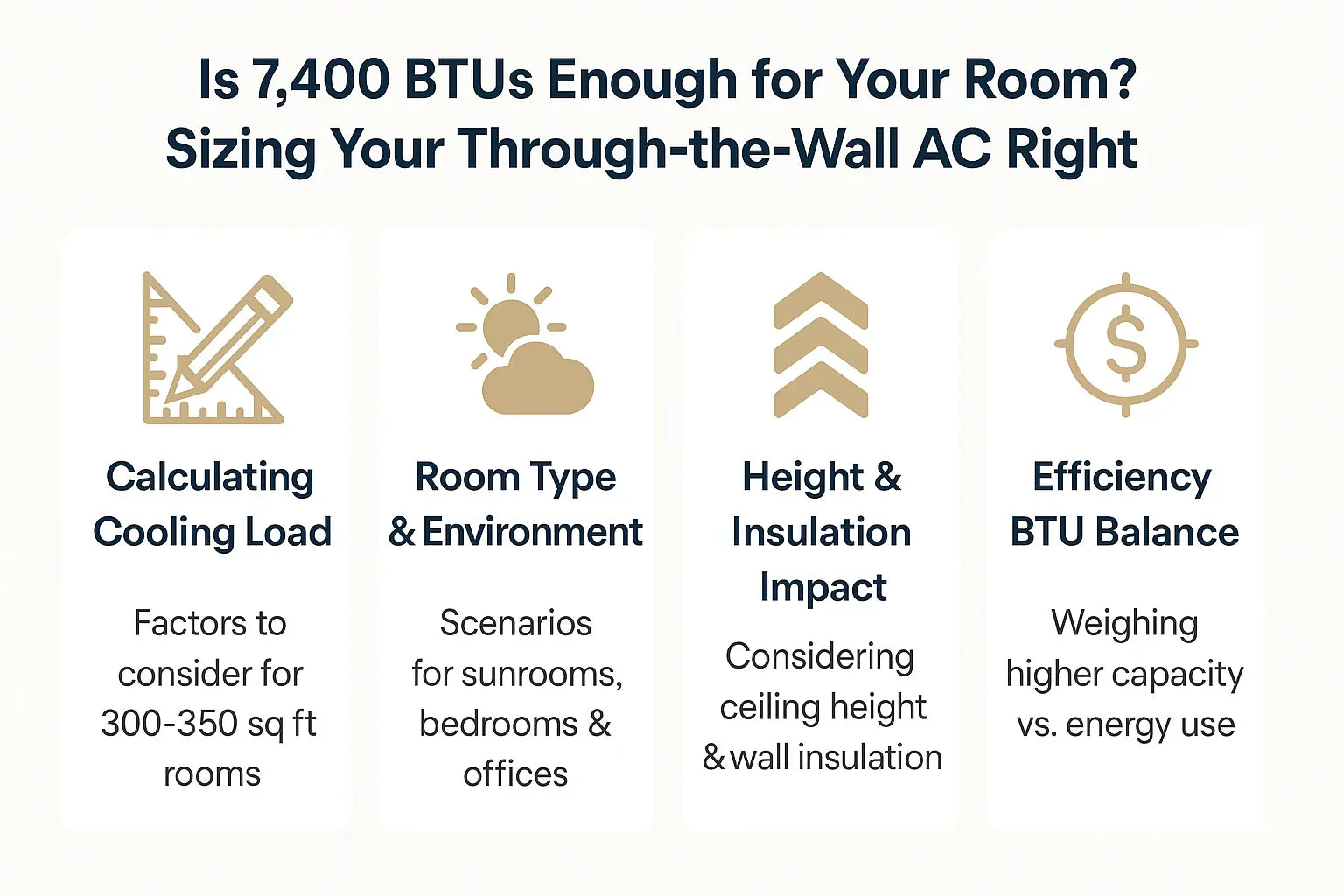Choosing the correct size for your through-the-wall air conditioner is one of the most critical steps you can take for home comfort and energy efficiency. Many homeowners, especially those upgrading to the Amana 7,400 BTU PBH073J35AA Through-the-Wall AC with Heat Pump, wonder: Is 7,400 BTUs enough for my space? This guide by Mike Sanders will walk you through how to calculate your room's BTU needs, factors that influence cooling, and practical examples to ensure you purchase the right unit for your comfort without wasting energy.
🌍 What Does BTU Mean?
BTU (British Thermal Unit) measures the cooling (or heating) capacity of your AC. The higher the BTUs, the larger the area the unit can cool. However, bigger isn’t always better—oversizing can cause your system to short cycle, reducing dehumidification and increasing wear.
-
7,400 BTUs typically suit spaces around 300-350 sq ft under average conditions.
-
Factors like insulation, ceiling height, sunlight, and number of occupants can increase or decrease your needs.
Further reading:
📏 How to Calculate Cooling Load for Your Room
Use this formula:
Cooling Load (BTUs) = Area (sq ft) x 20 BTUs
This estimate is for standard 8-ft ceilings and moderate insulation.
Example:
-
Room size: 15 ft x 20 ft = 300 sq ft
-
Cooling load: 300 x 20 = 6,000 BTUs
The Amana 7,400 BTU unit comfortably exceeds this, giving additional power for hotter climates or sun-exposed rooms.
🏠 Sunroom, Bedroom, and Office Scenarios
🌞 Sunrooms
-
Glass-heavy environments increase heat gain.
-
Increase the BTU estimate by 10-20%.
-
A 300 sq ft sunroom may require 6,600-7,200 BTUs.
🏠 Bedrooms
-
Add 600 BTUs per additional person if two or more people frequently occupy the room.
-
Electronics (TVs, computers) can add heat load.
🏢 Home Offices
-
Computers, monitors, and printers increase heat.
-
Consider an additional 500-800 BTUs for tech-heavy setups.
For these cases, the Amana 7,400 BTU through-the-wall AC is often ideal for rooms around 300-350 sq ft with moderate heat loads.
Further reading:
🌬️ Ceiling Height and Insulation Factors
Ceiling Height
-
Standard calculations use 8-ft ceilings.
-
For 10-ft ceilings, increase your BTU estimate by 10-20%.
Insulation Quality
-
Poor insulation increases cooling demand.
-
Older homes with minimal insulation may require an additional 10-15% in BTUs.
📆 Window Size and Sun Exposure
Rooms with large, south-facing windows receive more sunlight, increasing your cooling needs.
Guidelines:
-
Large window areas: Increase BTU estimate by 10%
-
Shaded rooms: You may decrease BTUs by 10%
🤝 BTU vs. Efficiency Trade-Offs
Selecting a higher BTU unit for your space can help on extremely hot days, but it may reduce energy efficiency if oversizing is significant.
An oversized AC may:
-
Cool air too quickly without proper dehumidification
-
Cycle on and off frequently, wearing down components
-
Increase electricity bills
A properly sized 7,400 BTU unit will:
-
Cool the space gradually
-
Maintain humidity control
-
Operate efficiently with less wear on components
Further reading:
🛠️ Matching BTUs to Room Size: Quick Reference Chart
| Room Size (sq ft) | BTUs Needed |
|---|---|
| 100-150 | 5,000 |
| 150-250 | 6,000 |
| 250-350 | 7,000-8,000 |
| 350-450 | 10,000 |
| 450-550 | 12,000 |
The Amana 7,400 BTU unit is optimal for 250-350 sq ft rooms with average conditions.
🌧️ Climate Zone Adjustments
Hot climates require higher BTUs for the same space.
-
Hot, humid climate: Add 10-20% BTUs.
-
Dry, cool climate: Standard calculation suffices.
Example: For a 300 sq ft room:
-
Standard: 6,000 BTUs
-
Hot climate (15% increase): 6,900 BTUs
-
The 7,400 BTU Amana unit is appropriate here.
Further reading:
🌌 Special Considerations
🛏️ Number of Occupants
Add 600 BTUs per additional person regularly in the room.
💻 Electronics
Computers, TVs, and gaming systems add to heat load. Add 500-800 BTUs for heavy electronics use.
🌞 Kitchen Use
If installing in a kitchen, add 4,000 BTUs to your calculation due to heat from cooking appliances.
🏛️ Using the Amana PBH073J35AA for Spot Cooling
Through-the-wall AC units like the Amana PBH073J35AA are excellent for zoned cooling:
-
Keeps occupied spaces cool without running central air for the entire home.
-
Ideal for sunrooms, home offices, or master bedrooms.
-
Heat pump capability provides supplemental heat in winter, saving on baseboard or central heating costs.
Further reading:
🛠️ Installation Tips to Optimize Performance
-
Install the unit at least 30-60 inches above the floor for even cooling.
-
Ensure the sleeve is properly sealed to prevent air leakage.
-
Confirm the dedicated 230/208V electrical circuit is installed to handle the unit.
-
Use curtains or shades to block direct sunlight when needed to reduce load.
🏡 Conclusion: Is 7,400 BTUs Enough?
For most bedrooms, home offices, and small living areas between 250-350 sq ft, the Amana 7,400 BTU Through-the-Wall AC with Heat Pump offers an ideal balance of power, efficiency, and comfort.
If your space has:
-
High ceilings
-
Large sun exposure
-
Multiple electronics
-
More occupants
-
Poor insulation
you may be at the upper end of the 350 sq ft limit, but this unit will still perform reliably when used with shades and ceiling fans for optimal comfort.
💡 Next Steps:
-
Measure your room’s dimensions and ceiling height.
-
Use the guidelines above to estimate your BTU needs.
-
Check your electrical compatibility for the 230/208V requirement.
-
Order your Amana PBH073J35AA for energy-efficient zoned comfort.
-
Prepare your wall sleeve and consider professional installation for a clean, sealed fit.
By using these guidelines, Mike Sanders helps you make an informed, confident decision for your home. The Amana 7,400 BTU Through-the-Wall AC can keep your living spaces cool and comfortable while maintaining energy efficiency, reducing overall costs, and improving your daily comfort without oversizing and wasted energy.
In the next topic we will know more about: Through-the-Wall vs. Window AC Units: Which Is Right for Your Small Space?







